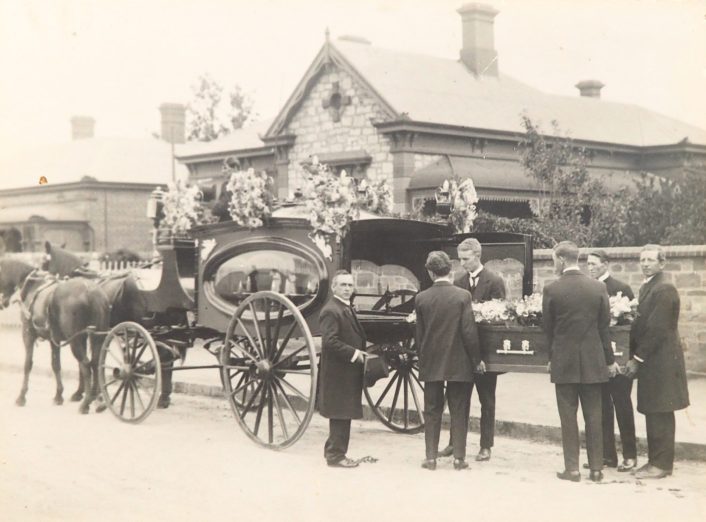Wrapping up his series on commercial horse-drawn vehicles in the National Trust collection, honorary curator Peter Foster focuses, fittingly, on vehicles designed for life’s last ride – the hearse!
The hearse emerged as a distinctive type of vehicle in the 17th century – a rather basic two or four-wheeled vehicle with open sides designed to carry a casket to its place of burial. It evolved into well-sprung four-wheeled configurations, with glass panels on the sides and rear-door access for the casket. Driven from a front seat, they were mostly pulled by two black horses. If not black, they were adorned in black rugs with black plumes attached to the harness, presenting a visual spectacle despite its sombre purpose.
The earliest records of hearses in Australia depict them as little more than drays, as in S.T. Gill’s lithograph Bush Funeral (1864), and Frederick McCubbin’s painting A Bush Burial (1890), where the deceased has been carried to a lonely grave in a springless dray. However, specially constructed hearses made their appearance in Sydney following the establishment of larger burial grounds in that city. This meant funeral processions often covered greater distances, necessitating a more sustainable transport unit.
By the 1850s, hearses were available in a range of highly ornamented styles, brought about by the increased social importance of funerals in the Victorian era. The over-wrought fussy finery reflected the gloomy pomp. For the coachbuilder, the hearse was a conduit to exhibit his skill. Very few vehicles gave him better opportunity for lavish carving and commanding ornamentation, providing the undertaker operated in a wealthy community able to afford such displays of dignified opulence.
Often the funeral cortege for notable citizens and dignitaries was accompanied by a number of attendant vehicles. Although not a specific design, mourning coaches for family and friends were kept in the coach-house. Various vehicles assumed the role, such as broughams, landaus or hooded wagonettes, all painted black.
One of the earliest examples of a developing funeral industry appears in an early advertisement published in The Sydney Gazette on 25 March 1824: ‘Edward Hunt, proprietor of the New State and Travelling Hearse, respectfully informs the Public, that he will perform Funerals in a superior Manner’.
Funerals were not always so well ordered. In The Funerals of Malachi Mooney published in 1900, Australian short story writer Edward Dyson describes the unfortunate scene that unfolds as Mooney’s cortege makes its way to a cemetery in Ballarat after a wake that lasted all night, lubricated by kegs of whisky. Leading the procession was a butcher’s wagon converted into a hearse, driven by Michael Morrisey, with the only black horse in the district between the shafts – an old trotter called The Imp.
The funeral moved at eleven, when it was quite certain that only one baby keg remained. This keg Morrissey took with him on the improvised hearse, as a wise provision for the first half of the journey, which lay through a barren land. Many of the mourners had to be helped into their vehicles, and after the start many remained in only by a miracle. Morrissey led the way, The Imp stepping along with a frivolous kind of a four-footed jig that robbed the cortege at the outset of any dignity… A dozen sleeping, unshaven, unshorn agriculturalists brought up the rear, riding two abreast on large, morbid horses that shuffled moodily through the dust with drooped heads and sagging under-lips…. Meanwhile, the day being hot and the way dusty, a couple of short halts had served to drain the keg on the hearse.
While undertaking businesses in the cities provided a comprehensive service, those in small country towns and hamlets operated quite differently. As the most skilled workers in timber available, local coachbuilders and wheelwrights made the coffins, often for walking funerals. As the community expanded, they became the town’s funeral provider.
Of the three hearses in the collection, two developed in this manner – one built by the coachbuilder, blacksmiths and wheelwrights H. Mickan of Rhine Valley (now Cambrai) in 1886; the other by the Aldinga coachbuilder John Noah Crisp and his foreman John Nelson, in about 1887. The Mickan hearse was used by the Mickan family in the undertaking part of their business until motorised vehicles became more prevalent prior to the Second World War. The third hearse was purchased by Mr J. Templar of Woodside, a builder and contractor, and used by him and his son for funerals in that town. It was built in Mannum, date unknown. Mr Robert Mitchell of Woodside recalls it being used for his brother’s funeral in 1919.
A testimony to the quality craftmanship in the construction and decoration of horse-drawn hearses is the number that were adapted and used on later motorised hearses.


